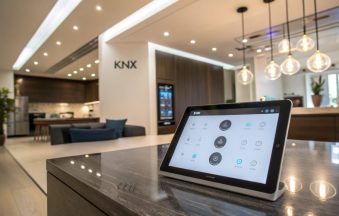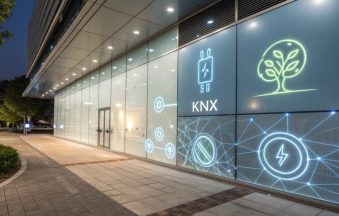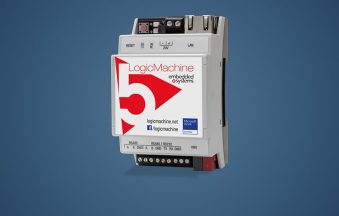HDL GRMS: Delving Deeper into the Technical Core
For the architects, system integrators, and tech enthusiasts who frequent KNXMAN.com, understanding the underlying technical prowess of a solution is paramount. While HDL GRMS undoubtedly delivers a superior guest experience, its true power lies in its robust engineering. Today, we peel back the layers to examine the technical foundations that make HDL GRMS a leading choice for sophisticated hospitality environments.
The Backbone: HDL Buspro Protocol
At the heart of the HDL GRMS solution is HDL Buspro, HDL’s proprietary wired communication protocol. This is a crucial distinction. Unlike some wireless systems that can suffer from interference, latency, and security vulnerabilities in high-density deployments like hotels, Buspro offers:
- Reliability and Stability: As a wired protocol, Buspro ensures consistent and robust communication between all devices within the GRMS ecosystem. This is vital for critical functions like HVAC control, lighting, and security, where uptime and immediate response are non-negotiable.
- Scalability: Buspro is designed to handle a large number of devices and extensive networks, making it ideal for everything from small boutique hotels to large-scale hotel chains with hundreds of rooms.
- Dedicated Power and Data: The Buspro cable carries both power and data, simplifying installation and reducing cabling complexity. This is a significant advantage during the design and deployment phases of a project.
- Security: A closed, wired system inherently offers a higher level of security against external interference and unauthorized access compared to open wireless protocols.
Within the Buspro framework, HDL GRMS leverages specialized modules and controllers:
- Hotel Room Control Host (e.g., HDL-MHRCU.433): This is the central processing unit for each guest room or a group of rooms. It manages the logic, receives commands from panels, and sends instructions to actuators for lighting, curtains, and HVAC. These hosts typically offer numerous channels (e.g., 48 channels) to control various loads.
- Room Controller Units (RCUs): These compact devices are often installed within the room to manage local loads and interact with sensors and control panels.
- Actuators (Relay, Dimming, Curtain): These are the workhorses, converting digital commands from the control host into physical actions – switching lights, dimming circuits, or controlling curtain motors. HDL offers a wide range of actuators with various channel counts and load capacities.
- Smart Panels & Key Card Readers: These are the primary guest interfaces. HDL offers touch panels (like the MPTLC43.46 previously discussed) and dedicated key card readers (e.g., MHIC.48) that integrate directly with the Buspro network. The key card readers are particularly clever, often distinguishing between guest, staff, and service cards to trigger different room scenarios (e.g., “Welcome Guest,” “Maid Service,” “Do Not Disturb”).
Interoperability and Integration with Third-Party Systems
While HDL Buspro forms the core, a truly comprehensive GRMS solution must integrate seamlessly with other vital hotel systems. HDL addresses this through various gateways and robust integration capabilities:
- PMS Integration (Property Management System): This is perhaps the most critical integration point. HDL GRMS can exchange data with leading PMS platforms (e.g., Fidelio/Opera, OnQ, Micros) via standard protocols like TCP/IP. This allows for automated check-in/check-out scenarios, room status updates, and guest profile synchronization, significantly enhancing operational efficiency.
- HVAC System Integration: Beyond local fan coil control, HDL GRMS can integrate with centralized HVAC systems (VRV/VRF) through gateways or via Building Management Systems (BMS) protocols like BACnet or Modbus. This ensures a holistic approach to climate control and energy management across the entire property.
- BMS Integration (Building Management System): For larger hotels, integrating GRMS with a wider BMS is essential. HDL provides gateways (e.g., KNX Gateway M/GWASC.1) that enable communication with common BMS protocols like BACnet, Modbus, and even KNX. This allows a central BMS to oversee and manage the entire building’s infrastructure, including individual guest rooms.
- Audio/Video & Entertainment Systems: Modern GRMS solutions extend to controlling in-room entertainment. HDL GRMS can integrate with IP-based entertainment systems, allowing guests to control TVs, music, and multimedia content directly from their touch panels or even via voice commands through integration with popular voice assistants (e.g., Amazon Alexa, Google Assistant).
- Security Systems: Integration with fire alarm systems, access control, and other security infrastructure ensures a coordinated response in emergencies and provides a comprehensive security overview.
- IoT & Cloud Connectivity: HDL’s focus on modern technology means their systems can connect to the cloud, enabling remote monitoring, data analytics, and potentially leveraging IoT services for further optimization. This also supports mobile app control (like the “HDL ON” app) for both guests and staff.
The KNXMAN Perspective on HDL’s Technical Edge
For the KNX community, HDL’s commitment to robust wired protocols like Buspro offers a clear advantage in reliability and security. While KNX itself is a different standard, HDL’s development of gateways to KNX (e.g., HDL-MCEIB.231 KNX-EIB Interface Converter and M/GWASC.1 KNX Gateway) demonstrates their understanding of the broader building automation landscape and their dedication to interoperability. This means that even if a hotel already has some KNX infrastructure, HDL GRMS can be seamlessly integrated, protecting existing investments while introducing cutting-edge guest room management.
The meticulous design of HDL’s hardware, from the durable touch panels to the robust actuators, combined with the power of the Buspro protocol and extensive integration capabilities, positions HDL GRMS as a formidable solution. It’s not just about turning lights on and off; it’s about intelligent, interconnected control that meets the complex demands of high-end hospitality.







Add comment